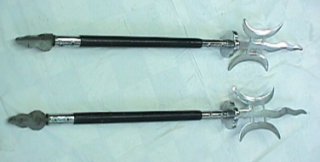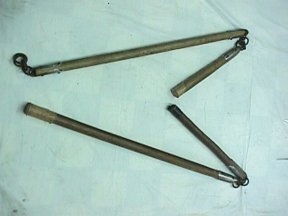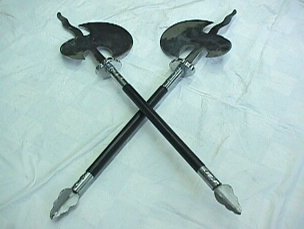| Daqiang ( Great Spear ): The most commonly seen daqiang is approximately ten feet long. Compared to the common qiang, the daqiang is much heavier. It techniques are also difference. The strengths of this weapon is the power it produces. |
| Sanjiandao: A pole-arm, also known as Erlangdao. Legend has it that it was the weapon of the famous god Erlangshen. In the front of this weapon, there are three blades like a fork. Both sides of the blade is sharpened making his techniques unique. Aside from the common moves of the Dadao, it also has the use of sou and chan. Together with various footwork and body movements forms are complete routine. In this day, there are very little schools which teaches this weapon. Information says that Shaolin and Preying Mantis teaches this weapon. |
| Dapa: Also known as Cha, it is another pole-arm as well as a heavy weapon. In the early stage, it was used for hunting large wild animals. It was split into two or three spikes. The three spiked version has one in the middle of the two. The two on the side each measures around three to four inches. Main techniques for this weapon includes lan, heng, qian, tiao, ci, guan, pai, gun, zha. |
| Mau: Also known as Shemauqiang. It was made famous from its use by Zhang Fei during the times of the three kingdoms. To practice this weapon, it is required that the person to stay as close to the weapon as possible and the blade never leaving the centre Main moves includes pi, za, gun, bang, dou, chan, tsou, tiao, etc. In Kong Kong, Choi Li Fut and Shaolin teaches this weapon. |
| Dadao: One of the Pole-arms, it is one of the preferred weapons for generals in combat in times of war. Main moves includes pi, liao, mo, gua, chou, zhan, yun, tou, duo, chuan, zai, lan, tiao, etc. The correct way of performing these moves includes the hand not leaving the guard, power infused in the blade, move in all four directions, etc. In Hong Kong, the teaching of this weapon is very common. Including in the school of Preying Mantis in the form of Chunqiu-dadao, Qinglung-yanyue-dao, Lingnan's Tsaiyangdao(See image), Jiuhuan-dadao, Lanmen-jaidao, Shaolin's Shimen-dadao and Wangjong-dadao, etc. |
| Chan: Mostly used by monk, this weapon comes in various forms as well as names. For example Fangbianchan, Jinzhongchan and Yueyachan. It moves are quite similar to the dapa, such as tsou, ya, pai, zhi, gun, chan, zai, tiao, etc. In practice, is is fast and dynamic with many combinations of body moves. The North Shaolin of Hong Kong as well as Xingyiquan practices this weapon. |
| Jie (Changjie) : Jie could be split into two forms of long and short. Because of the difference in shape, it could also be known as Fangtianjie( right ) and Huajie(left )Gujie, Hudiejie, etc. It's moves are unlike those of qiang, mau, dao or fu. Mainly in the form of "Wun". Through this, there are moves like chongchan, hweikan, hengci, shapici, shelei, etc Also difference exists in the form of circular movements. Moves such as hengkan, zaige, etc shows this point. Schools which teaches this weapon includes Taiji Preying Mantis' Lubujie, Paqua-lulujie and Shaolin's Fangtianjie. |
| Yue: In the ancient times, fu(axe) and yue is the same thing. A jufu (large axe) with a long handle is called a yue. Because of the difference of uses, fu and yue does have their differences. Whenever there are hooks on the back of the axe and spear points on the head is classified as yue. yues are used on the battle field for warriors on horsebacks. Its characteristics are quite similar to the fu. But in addition, it has moves such as ci, gou, zhuang, etc. In Hong Kong, the styles which teaches this weapon is Taiji Preying Mantis' Kaishanyue. |










